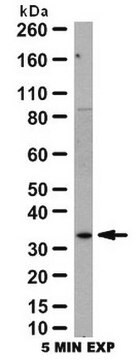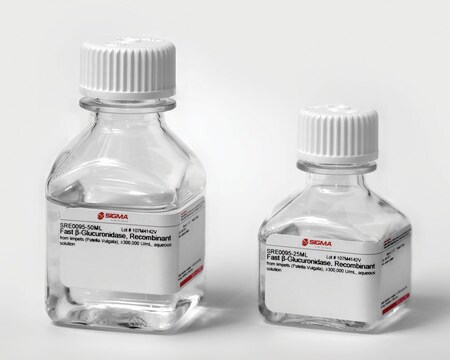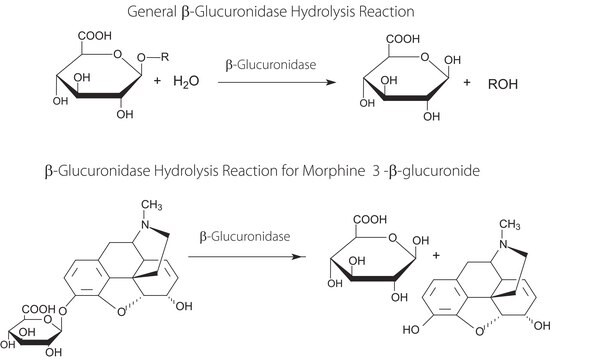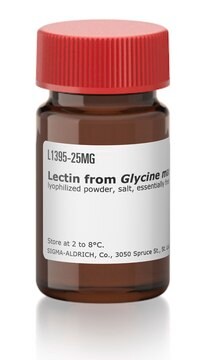Wszystkie zdjęcia(1)
Kluczowe dokumenty
G5170
Galectin-3 human
recombinant, expressed in E. coli, lyophilized powder
Synonim(y):
CBP 35, Carbohydrate-binding protein 35, Gal-3, Galactose-specific lectin 3, Galactoside-binding protein
Zaloguj sięWyświetlanie cen organizacyjnych i kontraktowych
About This Item
Polecane produkty
rekombinowane
expressed in E. coli
Poziom jakości
Formularz
lyophilized powder
numer dostępu UniProt
temp. przechowywania
−20°C
informacje o genach
human ... LGALS3(3958)
Opis ogólny
Galectin-3 protein comprises a N-terminal flexible domain and a C-terminal carbohydrate-recognition domain (CRD). It is mapped to human chromosome 14q22.3. Galectin-3 is expressed in sensory neurons, immune endothelial and epithelial cells.
Zastosowanie
Galectin-3 human has been used:
- to test its interaction with N-acetyl lactosamine coated onto quantum dots
- to optimize Gal3-induced hemagglutination measurements in non-agglutinated or agglutinated chicken red blood cells (RBCs)
- in Gal-3 binding assay of serum samples from multiple sclerosis patients
Działania biochem./fizjol.
Galectin-3 (Gal3) has anti-apoptotic property and mediates adhesion of cancer cells to endothelium. The activity of Gal3 is inhibited by lactose. High levels of Gal3 is associated with cardiovascular disease and is a potential biomarker in fibrosis and inflammation associated with heart failure. Gal3 is involved in variety of biological events from differentiation to host defense and immunomodulation. Gal3 gene deletion is correlated to renal function anomalies like nephropathy. It is implicated in the pathogenesis of retinopathy and non-alcoholic fatty liver disease (NAFLD).
Galectin-3 has been associated with the inhibition of apoptosis and the progression of cancer, as well as being a mediator of inflammation. Studies have found a positive correlation between the expression of galectin-3 and tumorigenicity and metastasis in colon, liver, and thyroid cancer.
Inne uwagi
Galectin-3 is a member of the family of animal lectins, which selectively binds β-galactoside residues.
Postać fizyczna
The product is lyophilized from water with 2 μg of lactose as stabilizer per μg of galectin-3.
Ta strona może zawierać tekst przetłumaczony maszynowo.
Kod klasy składowania
11 - Combustible Solids
Klasa zagrożenia wodnego (WGK)
WGK 2
Temperatura zapłonu (°F)
Not applicable
Temperatura zapłonu (°C)
Not applicable
Środki ochrony indywidualnej
Eyeshields, Gloves, type N95 (US)
Wybierz jedną z najnowszych wersji:
Masz już ten produkt?
Dokumenty związane z niedawno zakupionymi produktami zostały zamieszczone w Bibliotece dokumentów.
Matthew R Kovak et al.
American journal of reproductive immunology (New York, N.Y. : 1989), 72(4), 403-412 (2014-05-28)
Galectin-3 is a β-galactoside binding protein with immunomodulatory properties and exerts its extracellular functions via interactions with glycoconjugate ligands. Therefore, to elucidate the function of galectin-3, binding ligands in human seminal plasma were investigated. Galectin-3 binding proteins were isolated from
Rui Dong et al.
International journal of molecular medicine, 41(2), 599-614 (2017-12-06)
Galectin-3 is a member of the galectin family, which are β‑galactoside‑binding lectins with ≥1 evolutionary conserved carbohydrate‑recognition domain. It binds proteins in a carbohydrate‑dependent and ‑independent manner. Galectin‑3 is predominantly located in the cytoplasm; however, it shuttles into the nucleus
Wei Zhao et al.
Analytical biochemistry, 571, 37-39 (2019-02-25)
Hemagglutination inhibition (HAI) assay is a simple method quantifying relative binding activities of glycan-lectin interactions. Currently, interpretation of HAI data remains a manual task depending on visual observation. In this study we developed a digital data reading method for HAI
Synthesis of multivalent N-acetyl lactosamine modified quantum dots for the study of carbohydrate and galectin-3 interactions
Yang Y, et al.
Tetrahedron, 68(35), 7148-7154 (2012)
A Hoverfelt et al.
Diabetologia, 53(9), 1903-1907 (2010-05-22)
The AGE receptors 1, 2 and 3, which are encoded by DDOST, PRKCSH and LGALS3, respectively, may be involved in the pathogenesis of diabetic complications. We sought to find out whether these genes are associated with diabetic nephropathy, cardiovascular disease
Nasz zespół naukowców ma doświadczenie we wszystkich obszarach badań, w tym w naukach przyrodniczych, materiałoznawstwie, syntezie chemicznej, chromatografii, analityce i wielu innych dziedzinach.
Skontaktuj się z zespołem ds. pomocy technicznej






